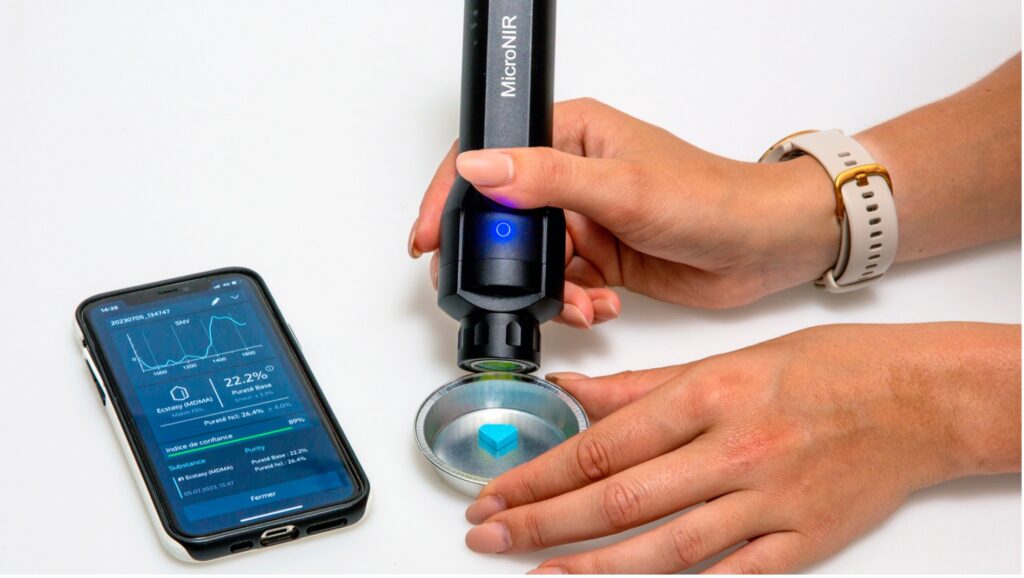This article has primarily been published in French in l’Uniscope, the magazine of the University of Lausanne in September 2025. Link to the original article.
For the past ten years, North America has been ravaged by drugs with ettects similar to those ot opium, causing more than 70,000 overdose deaths each year. Pierre Esseiva, professor at the School of Criminal Sciences, and Olivier Simon, physician at the CHUV Addiction Medicine Department and senior lecturer and researcher at the Faculty of Biology and Medicine, paint a picture of the situation in Switzerland.
Double over in pain, synthetic drug users fill the streets of the United States in broad daylight. Seeming to float between life and death, some spend their days consuming and searching for whatever will give them the dopamine rush they have become addicted to. The main cause of this crisis? A tiny blue pill: fentanyl. A synthetic drug that replicates the effects of morphine, just a microdose is enough to produce analgesic and psychotropic effects… and, not far from there, addiction or intoxication. In the United States, the number of fentanyl-related deaths is countless, and addiction is transforming lives and entire cities.
Is Switzerland suffering the same fate?
Recently, fear has made several appearances in the Swiss media: is Switzerland next on the list? To answer this question, we head to the narcotics testing department at the University of Lausanne’s School of Criminal Sciences. Holding a black device in his hand, Pierre Esseiva, a professor in the laboratory, scans a small yellow hexagonal pill. Within seconds, the results appear on his phone, whose screen displays “MDMA, 35.8% purity, 99% match”. “These are police seizures”, he explains. “Thanks to this instrument, for which our lab developed the database, we can get a quick analysis. At drug checking centres, anyone can bring in a substance to find out what it really contains
Currently in Switzerland, cocaine (or its derivative crack), heroin, ecstasy and (meth)amphetamine are the most commonly detected drugs in laboratory tests. “If fentanyl were to spread in Switzerland, we would have to put in place a specific protocol to detect it quickly,” says Pierre Esseiva. This would initially involve systematic analysis of specimens suspected of containing these opioids via the various drug checking settings deployed in the area.

In fact, fentanyl has already been found in Switzerland on several occasions, but these cases can be counted on one hand. Zurich has announced twice that it has detected this type of substance, and “we have been able to identify one or two people who were using fentanyl in Lausanne,” says Pierre Esseiva. Should we be alarmed? “No. In Switzerland, there is no market for fentanyl today. In the few cases observed, the users had ordered it themselves on the darknet, in full knowledge of what they were doing. It would become serious if fentanyl were suddenly used to cut other drugs that are more widely consumed and people had access to it without expecting it. That’s where the real problem would arise because, due to their potency, “these substances can cause overdoses in very small quantities; it’s really an on-off situation,” explains the professor of criminal science.
Not in Switzerland… or is it just a matter of time?
Could this respite disappear as quickly in Europe as it did in the United States? To answer this question, Pierre Esseiva explains how the US got to this point: “Over there, organised gangs followed in the footsteps of an addiction that was created by the liberal functioning of the medical system. “Starting in the 1990s, pharmaceutical companies heavily promoted opioids for pain relief, downplaying the risks of addiction. Millions of patients became dependent. Faced with an explosion of poisonings, the authorities closed the floodgates. Many addicts then turned to the illegal market, first to heroin, then to fentanyl. Mexican cartels seized this opportunity, as fentanyl is easier to produce, transport and conceal
than heroin. Since the substance is difficult to dose, its lack of regulation has led to the crisis we see today. In Switzerland, the framework conditions are very different from those in the US. “Swiss policy is based on four pillars,” continues the drug profiling specialist. “Prevention, treatment, enforcement and risk reduction. It is this Swiss policy that will, I believe, prevent a crisis like the one in the United States.” The combination of these four pillars, the regulation of pharmaceuticals, the accessibility of treatment for the target population (70-80% in Switzerland compared to only 10-20% across the Atlantic) and risk reduction measures, including safe consumption areas, seems to be bearing fruit. Today, opioid-related mortality has reached a gap of almost 30 times more deaths attributed to opioids in North America than in Europe.
“We are not ready”
Switzerland differs from the United States in many ways, but the risk is not zero. We now turn to the Addiction Medicine Department at CHUV, where Olivier Simon, senior physician and lecturer and researcher at the Faculty of Biology and Medicine at the University of Lausanne, urges us not to rest on our laurels. Co-author of a recent article on the subject in the Swiss Medical Weekly, he works with people affected by addiction and is responsible for overseeing opioid prescriptions. “We have a functioning infrastructure based on the pleasant idea that Switzerland set an example during the AIDS and heroin crisis in the 1990s. But this infrastructure has changed little in 30 years and no longer meets today’s challenges.” While he agrees with Pierre Esseiva that the likelihood of an opioid crisis such as that in the US occurring in Switzerland is low, he admits frankly: “The consensus among addiction professionals is that if the crisis does happen, we are not ready.”
Addiction: a bad conception
“The central mechanism of addiction is the pleasurable, or hedonic, effect associated with the properties of certain substances,” explains Olivier Simon. Any substance that produces sufficiently intense hedonic effects has the potential to be addictive in the long term. After a variable period of exposure, the part of the brain that regulates emotions goes into overdrive, and the perceived pleasure associated with it becomes, in a way, predatory to other sources of pleasure. The person’s life then reorganises itself around the behaviour and there is a gradual loss of control.
Abstinence, which is socially valued, is not synonymous with a return to health, however, since, with few exceptions, it will lead not only to transient physical symptoms, but also to severe anxiety and depression, with the risk of relapse. It is therefore crucial to be able to offer these patients a prescription for an appropriate pharmaceutical opioid, supervised by professionals.
“A naloxone antidote spray has been developed in North America for the emergency treatment of poisoning. But it is not currently available in Switzerland due to a lack of funding,” continues the senior doctor. He recommends revisiting the issue and providing better training for professionals: “I would like to see more emphasis placed on standardising the treatment of opioid related disorders so that they are not only provided in specialised centres. These skills need to be included in the basic training of doctors and pharmacists.”
What now?
This preparation can be difficult in a rapidly changing world. New synthetic drugs are frequently emerging. For this reason, Pierre Esseiva teaches a course at the School of Criminal Sciences entitled “Synthetic Drugs: A Current Issue in Toxicology and Public Health” in order to be able to adapt quickly. The synthetic drug market is also evolving, with many factors influencing it, as is currently the case with the geopolitical conditions in Afghanistan, which are destabilising the heroin market, with direct repercussions in Switzerland. It is therefore necessary to observe, analyse and, above all, communicate. In his laboratory, Pierre Esseiva stated: “If fentanyl or another powerful synthetic opioid were to arrive, the question would be how to respond quickly and effectively. And to do that, we need to bring the various players from the four pillars [prevention, treatment, law enforcement and harm reduction] together around the table.”
For now, the two professionals agree on one point: Switzerland is facing a crack problem which, even if the risk of overdose is lower than with the little blue fentanyl pill, represents a real challenge for our country.
To find out more…
- Read the article recently published in Swiss Medical Weekly, co-authored by Olivier Simon.
- Browse the work carried out by the School of Criminal Science on narcotics.
- And that of the Addiction Medicine Department at Lausanne University Hospital (CHUV).
- Find out more about the MonitorStup and drug checking projects.

